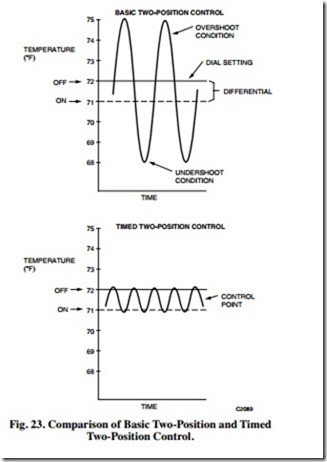TIMED TWO-POSITION CONTROL
GENERAL
The ideal method of controlling the temperature in a space is to replace lost heat or displace gained heat in exactly the amount needed. With basic two-position control, such exact operation is impossible because the heating or cooling system is either full on or full off and the delivery at any specific instant is either too much or too little. Timed two-position control, however, anticipates requirements and delivers measured quantities of heating or cooling on a percentage on-time basis to reduce control point fluctuations. The timing is accomplished by a heat anticipator in electric controls and by a timer in electronic and digital controls.
In timed two-position control, the basic interaction between the controller and the final control element is the same as for basic two-position control. However, the controller responds to gradual changes in the average value of the controlled variable rather than to cyclical fluctuations.
Overshoot and undershoot are reduced or eliminated because the heat anticipation or time proportioning feature results in a faster cycling rate of the mechanical equipment. The result is closer control of the variable than is possible in basic two- position control (Fig. 23).
HEAT ANTICIPATION
In electromechanical control, timed two-position control can be achieved by adding a heat anticipator to a bimetal sensing element. In a heating system, the heat anticipator is connected so that it energizes whenever the bimetal element calls for heat. On a drop in temperature, the sensing element acts to turn on both the heating system and the heat anticipator. The heat anticipator heats the bimetal element to its off point early and deenergizes the heating system and the heat anticipator. As the ambient temperature falls, the time required for the bimetal element to heat to the off point increases, and the cooling time decreases. Thus, the heat anticipator automatically changes the ratio of on time to off time as a function of ambient temperature.
Because the heat is supplied to the sensor only, the heat anticipation feature lowers the control point as the heat requirement increases. The lowered control point, called “droop”, maintains a lower temperature at design conditions and is discussed more thoroughly in the following paragraphs. Energizing the heater during thermostat off periods accomplishes anticipating action in cooling thermostats. In either case, the percentage on-time varies in proportion to the system load.
TIME PROPORTIONING
Time proportioning control provides more effective two- position control than heat anticipation control and is available with some electromechanical thermostats and in electronic and microprocessor-based controllers. Heat is introduced into the space using on/off cycles based on the actual heat load on the building and programmable time cycle settings. This method reduces large temperature swings caused by a large total lag and achieves a more even flow of heat.
In electromechanical thermostats, the cycle rate is adjustable by adjusting the heater. In electronic and digital systems, the total cycle time and the minimum on and off times of the Fig. 25. Relationship between Control Point, and Load (Heating Control).
controller are programmable. The total cycle time setting is determined primarily by the lag of the system under control.
If the total cycle time setting is changed (e.g., from 10 minutes to 20 minutes), the resulting on/off times change accordingly (e.g., from 7.5 minutes on/2.5 minutes off to 15 minutes on/5 minutes off), but their ratio stays the same for a given load.
The cycle time in Figure 24 is set at ten minutes. At a 50 percent load condition, the controller, operating at setpoint, produces a 5 minute on/5 minute off cycle. At a 75 percent load condition, the on time increases to 7.5 minutes, the off time decreases to 2.5 minutes, and the opposite cycle ratio occurs at 25 percent load. All load conditions maintain the preset 10-minute total cycle.
Because the controller responds to average temperature or humidity, it does not wait for a cyclic change in the controlled variable before signaling corrective action. Thus control system lags have no significant effect.
Droop in heating control is a lowering of the control point as the load on the system increases. In cooling control, droop is a raising of the control point. In digital control systems, droop is adjustable and can be set as low as one degree or even less. Figure 25 shows the relationship of droop to load.
Time proportioning control of two-position loads is recommended for applications such as single-zone systems that require two-position control of heating and/or cooling (e.g., a gas-fired rooftop unit with direct-expansion cooling). Time proportioning control is also recommended for electric heat control, particularly for baseboard electric heat. With time proportioning control, care must be used to avoid cycling the controlled equipment more frequently than recommended by the equipment manufacturer.


